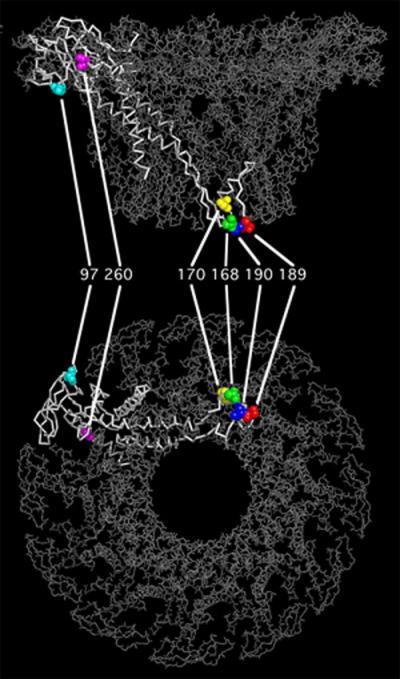The life cycles of many viruses include a self-assembly stage in which a powerful molecular motor must pack the DNA genome into the virus's preformed shell (the capsid). How it manages this intricate feat has been subject to debate, but we know that the DNA passes into the capsid shell through a channel formed by a structure called the connector. Scientists have speculated that rotation of the connector complex might feed the DNA into the capsid as it turns.
In a new study published online this week in the open access journal PLoS Biology, researchers Thorsten Hugel, Jens Michaelis, Craig Hetherington, and Carlos Bustamante present their detailed investigation into how the Bacillus subtilis bacteriophage ö29 crams its DNA into the capsid following replication. Double-stranded DNA is driven into the preformed capsid shell by a complex and powerful molecular motor. Credit: Image: Precision Graphics (Champaign, Illinois), K. Aathavan and Y. Chemla (University of California Berkeley)
Double-stranded DNA is driven into the preformed capsid shell by a complex and powerful molecular motor. Credit: Image: Precision Graphics (Champaign, Illinois), K. Aathavan and Y. Chemla (University of California Berkeley)
Using their innovative system, Hugel and colleagues were able to observe capsids as they pack their DNA to directly test the connector rotation hypothesis. They found that it is more than likely not the mechanism by which the DNA is packed. The researchers combined single-molecule fluorescence polarization with "magnetic tweezers" to glue the end of the capsid farthest from the hole to a slide using antibodies, and then they draw out the DNA being packaged in the opposite direction by attaching a magnetic bead to its loose end and applying a magnetic field. Importantly, they also labeled the connector complex with fluorescent dye molecules so they could observe its motion using single-molecule fluorescence polarization spectroscopy.
The researchers then looked at connector movement during DNA packaging in six ö29 mutants. After attaching the fluorescent molecules to the connector complex, they set the mutants to work packaging DNA in a flow chamber. As the connectors functioned, the researchers shone homogeneously polarized light on them and recorded the pattern of fluorescence produced in two channels at right angles to one other.
If the connectors had been rotating, they would have seen a sine wave-like fluctuation in intensity in both channels with a phase shift of 90 degrees. They did not see the sine waves, and mathematical analysis of the fluorescence pattern confirmed that the changes in the fluorescence emitted by the molecules as packaging took place did not correspond to any sort of continuous rotational motion. The researchers concluded with more than 99% certainty that the packaging mechanism does not involve rotation.
How, then, does it happen? The researchers noted that their findings are compatible with a recently proposed nonrotating model in which the ring of ATPases alternately compresses and extends, drawing in the DNA. But further testing will be needed to confirm the validity of that model to the degree of certainty with which this team rejected the rotator hypothesis.
This article was written from a news release by Public Library of Science